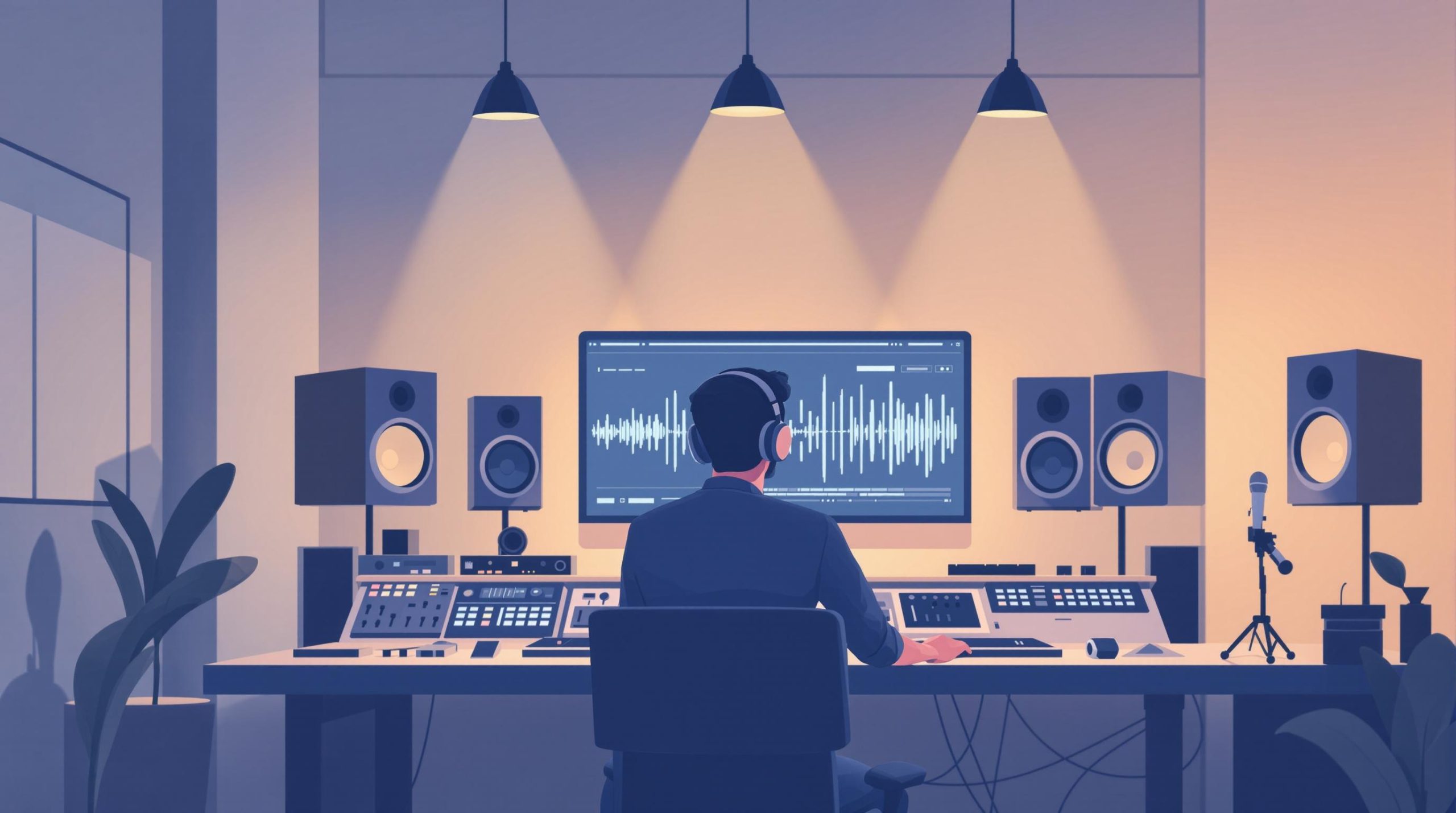AI is transforming sound design by automating the creation of realistic audio. Here’s how:
- AI Tools Save Time: They analyze data and generate sounds faster than traditional methods.
- Enhanced Precision: Systems like MMAudio align sounds with visuals for perfect synchronization.
- Creative Flexibility: Tools like ElevenLabs turn text descriptions into lifelike soundscapes.
- Key Technologies: Diffusion models refine noise into clear audio, while multimodal training blends text, visuals, and sound.
Quick Overview:
| Tool | Strength | Best Use Case |
|---|---|---|
| MMAudio | Synchronized audio-visual content | Video games, animations |
| ElevenLabs | Text-to-sound synthesis | Background sounds, ambient audio |
AI tools are reshaping industries like gaming, VR, and education by creating immersive, high-quality audio efficiently. However, ethical concerns like misuse for deepfakes highlight the need for responsible use.
Technologies Powering AI Sound Effects
Diffusion Models in Audio Synthesis
Diffusion models create sound effects by gradually refining random noise into clear audio, using patterns learned from training data. These models are at the core of AI sound design, offering a new level of realism and efficiency.
A great example is Google DeepMind‘s V2A technology. It encodes video input and refines audio step by step to ensure perfect synchronization [3]. By processing visual and textual inputs together, this technology excels at generating synchronized sound effects.
These models are particularly useful in areas like real-time gaming, animation, VR, and training simulations. Their iterative process ensures that audio aligns perfectly with visuals, making them indispensable for modern sound design.
Multimodal Training with MMAudio
MMAudio uses multimodal joint training to align audio with visual and textual inputs, drawing on context to produce accurate sound effects [2]. It’s trained on datasets like AudioSet and Freesound, giving it the flexibility to work with a wide range of audio types [4].
This platform processes multiple inputs at once, creating audio that fits seamlessly with the visual and textual elements provided. Whether it’s ambient noise, speech, or music, MMAudio can handle it all [4].
"MMAudio’s joint training method associates audio events with visual scenes and annotations" [2].
These advancements are already reshaping sound design across various industries, bridging the gap between technology and creativity.
Applications of AI in Sound Design
Using MMAudio for Sound Effects
MMAudio is a powerful tool for creating synchronized sound effects in multimedia projects. By combining audio with visual and text-based elements, it becomes especially useful for video games, animations, and interactive media [2]. The platform generates a variety of audio types while keeping them perfectly aligned with visual content. Its integration with Pinokio allows creators to produce sound effects directly within their projects, simplifying the creative process [4].
For instance, in game development, MMAudio can craft dynamic soundscapes that respond to player actions, delivering immersive audio experiences that align seamlessly with the on-screen activity [2].
Other AI Tools for Sound Design
While MMAudio focuses on synchronized audiovisual content, other AI tools bring unique strengths to sound design. ElevenLabs, for example, specializes in text-to-sound synthesis, transforming written descriptions into realistic ambient sounds [5].
"We used text prompts like ‘waves crashing,’ ‘metal clanging,’ ‘birds chirping,’ and ‘racing car engine’ to generate audio that we overlaid onto some of our favorite clips from the OpenAI Sora announcement." [5]
This makes ElevenLabs a great choice for creating background sounds or atmospheric effects, especially for silent footage or scenes that need an extra layer of realism [5].
| AI Tool | Primary Strength | Best Use Case |
|---|---|---|
| MMAudio | Synchronized audio-visual content | Video games and animated content |
| ElevenLabs | Text-to-sound synthesis | Background sounds and ambient effects |
These tools are transforming sound design workflows, allowing creators to produce high-quality audio efficiently while retaining full creative control [2] [5].
Guide to Creating Sound Effects with AI
Setting Up AI Tools
To get started with tools like MMAudio, download the model from trusted repositories such as AIModels.fyi [4]. Make sure your system is compatible, install all required dependencies, and test the setup using sample inputs. This step ensures everything runs smoothly as you dive into creating AI-generated sound effects.
Creating Custom Sound Effects
Once your tools are ready, you can start designing sound effects tailored to your project. AI tools like MMAudio allow creators to produce high-quality soundscapes efficiently, saving time without compromising on quality.
MMAudio is particularly useful for creating synchronized sound effects for multimedia projects [2]. When working with it, keep these key points in mind:
- Write clear and specific descriptions of the sounds you need.
- Set the desired audio duration.
- Adjust bitrate and frequency for the best sound clarity.
- Ensure sounds align perfectly with visuals.
MMAudio’s ability to handle multiple inputs at once makes it ideal for video games, animations, and interactive media [2][4]. In educational settings, AI-generated sound effects can create immersive audio tailored to specific scenarios, enhancing the learning experience [1].
For the best results, focus on providing detailed descriptions and maintaining proper synchronization with visuals. This ensures the generated audio fits seamlessly with your project while maximizing the tool’s capabilities in sound design.
sbb-itb-5392f3d
Future Trends and Ethical Issues in AI Audio
Advances in AI Audio Technology
The world of AI-generated sound effects is evolving rapidly, thanks to breakthroughs in multimodal training and diffusion models. Tools like MMAudio and V2A by Google DeepMind are reshaping audio synthesis, making it possible to synchronize sound with visuals more precisely. This has huge implications for industries like gaming and virtual reality (VR), where immersive sound design is a game-changer [3].
New tools are also making audio creation more accessible. For example, ElevenLabs allows creators to generate lifelike soundscapes from simple text prompts. This not only boosts efficiency but also gives users more control over the creative process [5]. However, as these technologies advance, they bring with them some tricky ethical questions.
Ethical Challenges in AI Audio
The rise of AI audio tools opens up exciting opportunities but also creates ethical dilemmas. Misuse of this technology for deepfakes or fraudulent content is a growing concern [5].
Here’s a look at some of the main challenges and possible solutions:
| Challenge | Solution | Strategy |
|---|---|---|
| Audio Deepfakes | Watermark AI content | Automated verification systems |
| Content Verification | Authentication tools | Digital signatures and tracking |
| Misuse Prevention | Usage guidelines | Industry-wide standards |
To ensure these tools are used responsibly, developers should focus on:
- Transparency: Clearly labeling AI-generated audio.
- Authentication: Using systems to verify the origin of content.
- Ethical Standards: Establishing clear rules for responsible use.
AI sound effects have enormous potential, especially in virtual and augmented reality, where dynamic and context-aware audio can transform user experiences [5]. By emphasizing transparency, robust authentication, and ethical practices, the industry can harness this potential in a responsible way.
Conclusion
AI’s role in sound design is reshaping how audio is created, allowing creators to produce high-quality sound effects faster and more efficiently than ever before. With tools like diffusion models and multimodal training, industries such as gaming and multimedia can now create interactive, context-sensitive soundscapes that enhance user experiences [3]. These advancements make professional sound design tools more accessible without compromising on quality.
This progress isn’t just about technical improvements. Game developers can craft audio environments that react to player actions, and multimedia teams can create custom sound effects in record time. Smaller production teams, in particular, have gained access to tools that were once out of reach, leveling the playing field for professional-grade sound design [2] [4].
As AI tools become more advanced, they continue to expand the possibilities in audio synthesis. The development of these technologies points to a future where sound design is not only more powerful but also easier to access. However, ensuring responsible use remains essential as technology and creativity come together to unlock new opportunities for creators of all skill levels [5].
AI’s impact on sound design is a game-changer, offering new ways to create professional-quality audio while advancing the technical landscape. This blend of innovation and responsibility highlights how AI is shaping a more dynamic and inclusive future in audio creation.
FAQs
How does AI generate sound?
AI creates sound effects using two main technologies:
Diffusion Models: These models convert random noise into realistic sound by learning patterns from audio data, as explained earlier [3].
Multimodal Training: Systems like MMAudio use inputs such as text and video to produce synchronized sound effects. They rely on large datasets like AudioSet and Freesound [2] [4].
The process generally involves two key stages:
| Stage | Description |
|---|---|
| Input Analysis | The system processes inputs and identifies relevant sound patterns. |
| Sound Generation | It then creates and fine-tunes synchronized audio output. |
Tools like the EON AI Sound Effect Generator make it possible to turn text descriptions into fitting sound effects [1]. This has made sound design more accessible in industries like gaming and multimedia.
These advancements highlight AI’s growing role in audio creation, helping designers build immersive soundscapes. However, as discussed in earlier sections, this progress also brings up important questions about ethical use and responsible development [2] [4].

